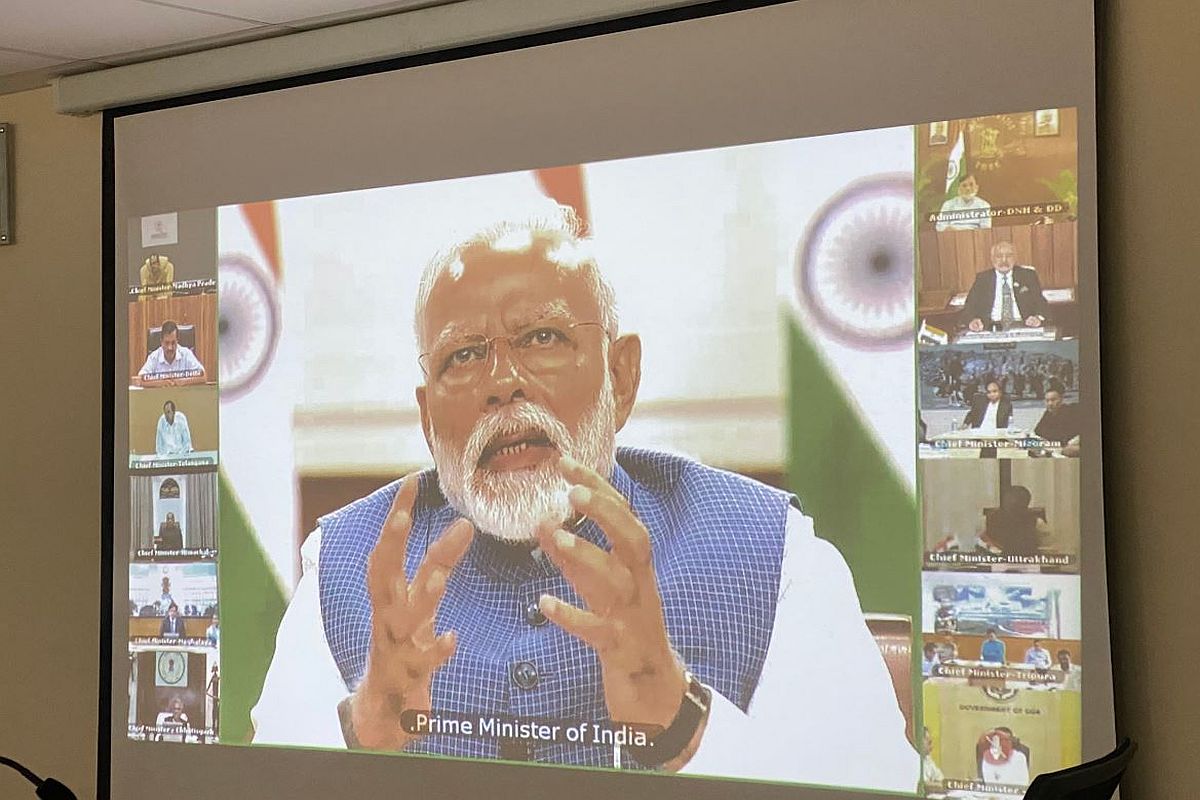Congress’ dangerous claws will snatch your rights: Modi
Modi said that women preserve gold, silver, and household items for their children. Congress and SP have noticed this.
Meanwhile, the Union Health Ministry on Thursday said it has identified 20 existing and 22 potential hotspots of COVID-19 in the country and asserted that although there is no evidence of widespread community transmission, containment measures will require large human resource.

Prime Minister Narendra Modi addressing Chief Ministers via video conferencing. (Photo: Twitter | @PemaKhanduBJP)
In the first video conference with all Chief Ministers amidst the COVID-19 coronavirus pandemic, Prime Minister Narendra Modi on Friday asked the head of the states to be alert and stressed on the formulation of a common exit strategy to ensure staggered re-emergence of population once the nationwide lockdown concludes.
“Our goal is to ensure minimum loss of life:,” said Modi during video interaction with the chief ministers on tackling COVID-19.
He said it “can’t be business as usual” after the lockdown and certain safeguards would have to be taken.
Advertisement
Arunachal Pradesh Chief Minister Pema Khandu also shared clippings from the meeting between state CMs and Prime Minister Modi.
“May not the 21-day lockdown go waste. Even after lockdown, follow corona prevention safety measures like wearing mask, cleanliness, distancing etc. Being responsible will save us,” the Prime Minister said as per a tweet by Khandu.
During the meeting, PM Modi told the chief ministers that the authorities need to be alert round-the-clock to prevent rapid spread of COVID-19.
“War has just begun now. Let us no mistake. Every 24 hours we must be alert; unitedly we must fight to defeat the outbreak of COVID-19,” the Prime Minister said.
“This is a fight which must be fought by each of us. This is a war which cannot be left alone to health workers, policemen or the government. Time is now for all different ideologies to unite to defeat the enemy of mankind,” he added.
PM Modi said the time is ripe to leverage technology to fight Coronavirus and urged governments to not compete to announce packages. “It is for all of us to be realistic and practical. The fight could go for any length and we can’t predict how things will turn,” he advised.
The chief ministers, in their reply, mentioned their efforts to maintain social distancing, track suspect cases, identify and quarantine suspect cases arising from the Nizamuddin Markaz event, contain community transmission, boost medical infrastructure and strengthen medical workforce.
The Prime Minister said that in next few weeks, testing, tracing, isolation and quarantine should remain the focus areas. He also highlighted the necessity of maintaining supply of essential medical products, availability of raw material for the manufacture of medicines and medical equipment.
The Union Health Secretary apprised the dignitaries of the rise in cases in India, the spread of cases from Nizamuddin Markaz and preparations to tackle medical cases arising out of further spread of the virus.
Nine chief ministers participated in the meeting. Home Minister Amit Shah, Defence Minister Rajnath Singh and a few senior civil servants were seen in the hall with PM Modi but all were seated with some distance between them demonstrating the social-distancing rule.
The virtual conference comes as India recorded 1,965 cases of Coronavirus with 50 deaths. Of the 50 reported deaths, 12 have come in the last 24 hours alone.
PM Modi on March 24 announced a three-week nationwide lockdown to contain the Coronavirus pandemic forcing shops, factories and industries to be shut.
Meanwhile, the Union Health Ministry on Thursday said it has identified 20 existing and 22 potential hotspots of COVID-19 in the country and asserted that although there is no evidence of widespread community transmission, containment measures will require large human resource.
The ministry said this in an advisory on human resource management of COVID-19 to provide guidance to the states on manpower that can be mobilized for the management of the disease along with possible role assignments and their training requirements.
Advertisement